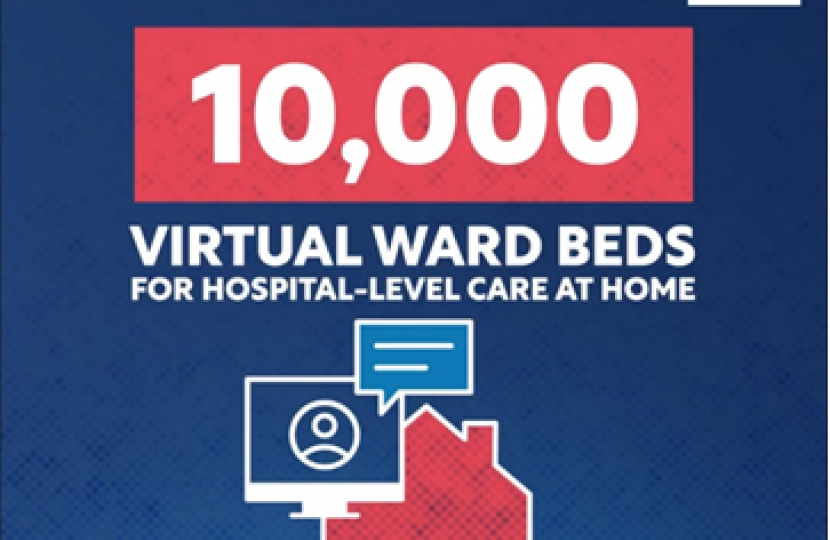
- The Government has delivered on its promise to roll out more than 10,000 virtual ward beds by winter.
- Virtual wards are a world-leading initiative that allows patients to get hospital-level care from the comfort of their homes.
- 240,000 patients have now been treated on virtual wards, helping to cut wait times and easing pressure on the NHS.
Greg Hands has welcomed the news that the NHS has now rolled out more than 10,000 virtual ward beds to care for patients in their own homes, helping to deliver on a key government priority to cut waiting lists.
Virtual wards allow patients to get hospital-level care at home safely and in familiar surroundings closer to family, friends, and carers, helping speed up their recovery while freeing up hospital beds for patients that need them most.
More than 240,000 patients have now been treated on virtual wards thanks to the world-leading initiative.
Research shows that people who are treated at home recover at the same rate or faster than those treated in hospital.
On virtual wards, patients are cared for by clinicians who can provide a range of care, including blood tests, prescribing medication, or administering fluids through an IV drip. They are reviewed daily with a home or virtual visit as part of the ‘ward round’, as well as the use of technology like apps, wearables, and other medical devices so staff can easily check in and monitor their recovery.
The introduction of 10,421 virtual ward beds will allow patients to get expert treatment for illnesses such as chronic obstructive pulmonary disease (COPD), heart failure or frailty conditions at home.
The ambition to deliver 10,000 virtual ward beds by the end of September was delivered despite considerable pressure on urgent and emergency care – September was the busiest month for ambulance services so far this year with 827,690 calls to 999 and a record September for the most serious ambulance incidents, with 77,553 category one callouts.
Last month was also the busiest ever September for A&E staff with 2,165,741 attendances, up almost 8% on the same month last year (2,008,489 in September 2022) and 522,000 emergency admissions last month, up 7.1% on September last year.
Commenting, Greg Hands said:
"This Government has delivered on its promise to roll out 10,000 virtual ward beds by the end of September.
Through this world-leading initiative, thousands of patients are receiving hospital-level care in their own home, where they feel most comfortable. This will help free up hospital beds for those that need them most, cut waiting times and ease pressure on the NHS ahead of the winter months.”
Commenting, Health and Social Care Secretary, Steve Barclay said:
“Thousands of patients have benefitted from the NHS’s ‘hospitals at home’, which give them the opportunity to recover in the comfort of their own homes while being monitored remotely by clinical staff. This approach, also known as ‘virtual wards’, has been shown to benefit patients and eases pressure on the NHS by freeing up hospital beds.
We have delivered on our promise to roll out 10,000 hospital-at-home places by winter – a key target in our Urgent and Emergency Care Recovery Plan and a testament to the hard work of NHS staff.
These ‘hospitals at home’ will speed up recovery times for patients and help cut waiting lists”.
Commenting, NHS National Medical Director, Professor Sir Stephen Powis, said:
“Our world-leading virtual ward programme is a huge leap forward in the way the NHS treats patients enabling them to receive hospital-level care in their own home.
The NHS is embracing the latest technology, with regular check-ins from local clinicians in daily ‘ward rounds’ while freeing up hospital beds for those that need them most – it is testament to the hard work and dedication of NHS staff across the country that we have delivered on our target and rolled out more than 10,000 virtual ward beds by the end of September.
We know that industrial action is also continuing to pile pressure on services and impact capacity adding a lot of pressure to hospitals before winter, coming on top of high levels of demand with last month seeing more 999 ambulance calls than any month this year as well as the busiest September ever for A&E attendances, up almost 8% on the same month last year.
But despite this pressure, it is clear from today’s figures that NHS staff are working incredibly hard to deliver for patients with 10% more patients coming off the waiting list in August than the same month before the pandemic”.
ENDS

